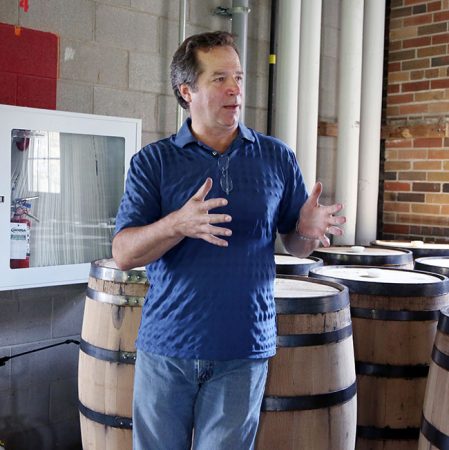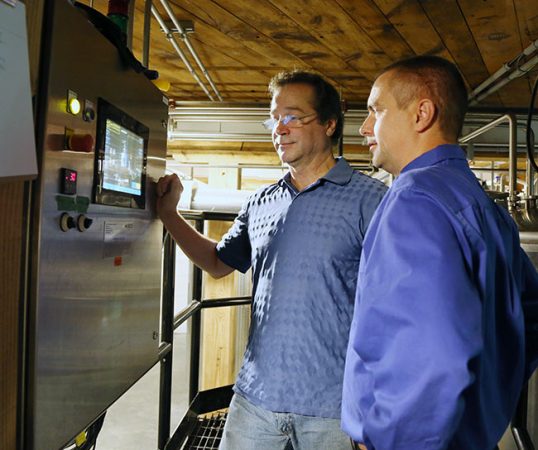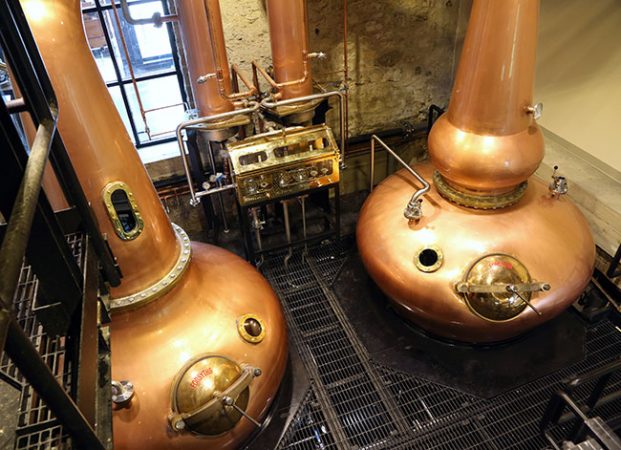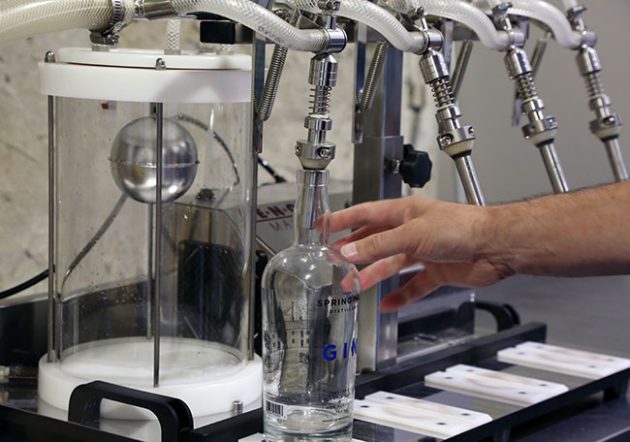
Team Spirits
George Guidoni
Automation Bottles Bottling Cans A.O. Wilson Ltd. Aztec Electrical Supply Inc. Bruni Glass Forsyths LCBO (Liquor Control Board of Ontario) LSI Control Systems Integration Canada ULC Omron Automation Americas Sapporo Breweries Sleeman Breweries Spring Mill Distillery StanpacUpstart craft distiller blends its brewing expertise with process control automation to put itself on solid growth path
Patience may be an increasingly rare virtue in today’s world of instant consumer gratification, but for companies focused on the timeless pursuit of quality, purity and craftsmanship, the ultimate rewards are more often than not well worth the wait.
As a founder and former owner of one of Canada’s most successful beer companies of all time, John Sleeman is a living personification of everything that is good and noble about artisanal authenticity in the production of high-quality, well-crafted and cleverly packaged products for which Canadian consumers will happily pay a well-earned premium in a compelling display of brand loyalty and appreciation.
Having steered the Guelph, Ont.-based Sleeman Breweries from its humble beginning in 1988 through its emergence and pre-eminence as one of Canada’s first large-scale craft brewers right up to its astonishing $400-million sale to global Japanese brewing giant Sapporo Breweries in 2006, Sleeman has definitely more than earned his right to coast and bask in the golden afterglow of an extraordinary career.
But that just wouldn’t be John’s style.

Vice-president of operations Doan Bellman, one of 14 investors who jointly own the craft distillery, was the original brewmaster at Sleeman Breweries, where he worked closely with the brewery’s well-known founder John Sleeman.
Rather, in addition to faithfully carrying on with his duties as a Sleeman Breweries chairman of the board, the 65-year-old entrepreneur is on a quest to replicate his remarkable success in the beer business with the new craft-spirits venture called Spring Mill Distillery.
Also located in Guelph, the recently-launched distiller is an independent, privately-funded enterprise co-owned by 14 individual investors—with Sleeman owning the biggest minority share—aiming to position itself as one of the country’s top producers of craft whiskey and other distilled spirits such as vodka and gin.
“John and I had initially started discussing this idea back in 2010,” says Spring Mill’s vice-president of operations and master distiller Doan Bellman, one of the distillery’s founding co-owners and, notably, the very first brewmaster that John Sleeman hired way back in 1988 to start his then-fledgling microbrewery in Guelph.
“We are both fans of fine whiskeys made around the world,” says Bellman, “and naturally we have plenty of background in alcohol beverage production that we think will give us a competitive edge in the growing market for craft whiskey.
“The difficulty is having to wait for three years to have a sellable [whiskey] product,” says Bellman, citing the patient aging process required to produce a quality whiskey, “whereas a startup brewery can have a sellable product in three weeks’ time.
“Hence this is a very patient money enterprise built on a lot of patient capital,” says Bellman, citing “many millions” of dollars spent on renovating and retrofitting the landmark 184-year-old building where Spring Mill has commenced production of its flagship Spring Mill brand of craft vodka and gin in early spring this year.

The clear custom-shaped 750-ml glass bottles supplied to Spring Mill by Bruni Glass are decorated using a high-end ACL (spliced ceramic label) printing process by Stanpac.
“We spared no expense in putting together what we think is the finest craft distillery in Canada,” Bellman told Canadian Packaging on a recent visit to the 20,000-square-foot operation housing two towering, four-meter-high copper pot stills hand-crafted in Scotland by the famed distillation equipment specialists Forsyths.
“It was a hugely capital-intensive project.”
Also housing two giant custom-built wooden “washback” vats made from the Douglas fir trees grown in Western Canada and shipped to Scotland for hand assembly, the designated Heritage Building facility has been making exceptionally good use of all the impressive best-of-breed distilling and processing equipment expertly laid out for optimal production throughout the building’s four storeys.
“We’ve been getting very good feedback right now on both our vodka and gin products,” says Bellman, adding the company is actively expanding its current limited base of about 100 LCBO (Liquor Control Board of Ontario) outlets carrying the premium-priced Spring Mill vodka and gin brands.
Currently retailing for $39.95 for a 750-ml bottle, the Spring Mill vodka and gin are packaged in shapely clear custom glass bottles supplied by Bruni Glass and deftly decorated via the high-end ACL (applied ceramic label) printing process by Stanpac in Niagara Falls, with Erin, Ont.-based A.O. Wilson Ltd. completing the packaging ensemble with tight-fitting wood-top bottle closures and the colored polylaminate bottleneck seals.
As Bellman readily agrees, the whole see-through look of the package is a nod to the once-revolutionary clear-glass beer bottles introduced to the Canadian beer market by Sleeman Breweries to great effect back in the 1990s to break up the decades-long stranglehold on Canadian beer bottle design by the so-called “stubby” bottles favoured by the country’s two dominant brewers Molson and Labatt’s.

Spring Mill’s vice-president of operations Doan Bellman (left) and Jeremy Meyer, territory account manager for central Canada with Omron Automation Americas, taking a look at live equipment status reports displayed in real time on the Omron touchscreen HMI (human-machine interface) terminal embedded into the plant’s main control panel.
“John always had a keen appreciation for the role that packaging plays in product marketing,” Bellman says, “and playing up the transparency angle with this see-through packaging look just seemed like a natural fit and compliment for our premium products that, in my opinion, are as good as any other established brands out there.”
As Bellman relates, “We are proud to be continuing on with the philosophy John started at the [Sleeman] brewery, which is based on the belief that having the right equipment, the right ingredients, and the right know-how can enable us to produce some of the finest products in the world.”
Says Bellman, “My experience as the Sleemans brewmaster and, in later years, as vice-president of technical services in charge of all the engineering, quality assurance and brewing, enables me to bring a lot of attention to detail in the brewing process that precedes the distillation stages of spirits production.
“Most people don’t know this,” Bellman explains, “but you need to be able make high-quality beer [on-site] before you can proceed to use that beer to make high-quality whiskey, or any other distilled spirit.
“You may have the best stills with the best separation technology,’ Bellman states, “but the stills will not fix any mistakes you may have made in the brewhouse earlier in the process.
“That’s why attention to detail in the brewing process is critical to translating that know-how into the quality final product.
“It is not the stills alone,” Bellman proclaims. “It is the whole process: from start to finish.”
To illustrate the point, Bellman likens operating a still to playing a complex musical instrument like the organ, “whereby you use different pieces of equipment to heat the liquid to release alcohol from the original [beer] solution and then condense the alcohol vapor back into the liquid form.
“You can play that tune in many different ways in terms of using different ingredients and all the different valves and other instrumentation to reach the desired boiling temperatures,” says Bellman, “which is why you have so many different vodkas out in the market, for example.
“There is a multitude of combinations and permutations of what you can do to effect the end product,” Bellman notes, “but it is the know-how behind the mechanical process of distilling that has the most important bearing on the final product quality.”
According to Bellman, Spring Mill goes through a lot of effort to source soft winter wheat to use as the base grain for its distilled products, along with many sought-after botanicals from around the world used for flavoring.

Measuring over three meters in height, the all-copper stills installed at the Spring Mill Distillery building were hand-crafted in Scotland by the world’s leading and best-known distillation equipment manufacturer Forsyths, founded back in the 1890s.
As for getting the distillery’s stills to perform like a fine-tuned organ, Bellman knew that the operation’s long-term success would be heavily dependent on installing the right process control solution, along with all related instrumentation and hardware, that would withstand the test of time and the vastly increased output down the road once the barrelled whiskies reached their maturity.
After trying several different engineering firms, Bellman eventually settled on proceeding with the project with LSI Control Systems Integration Canada ULC of Aurora, Ont., which has extensive experience of working with breweries and utilities that supply them with water and electricity.
“I have known Doan for a long time since Sleeman Breweries first opened up,” says LSI’s brand manager Ian Richardson, who spearheaded the fairly complex automation and integration project at the distillery that commenced in early 2018.
As Richardson relates, integrating automation at a retrofitted facility, rather than at a brand new one, presented a number of unique technical challenges to address.
“This was a brownfield site in a historic building,” Richardson says, “so Spring Mill had a lot of architectural issues for the trades people to work on, such as routing for electrical supplies, process piping and utility piping.”

Configured and integrated by LSI Control Systems Integration Canada ULC of Aurora, Ont., the OMRON Sysmac automation platform controlling Spring Mill’s distilling process controls a multitude of valves, switches, regulators, alarms and other critical instrumentation deployed on the high-end distilling equipment to ensure a smooth-running process
While that was being addressed, LSI began working on budgeting and preliminary drawings of how the system would operate, which Bellman quickly endorsed.
“Once we developed the process and instrumentation drawings, equipment lists, instrumentation selections and utility requirements, we started the automation discussions [and] by early 2018 we had a good handle on how the place was going to operate,” Richardson recalls.
While Spring Mill insisted on maintaining an artisanal hands-on approach to its production, “We both knew that there were many features that could be automated and displayed that could assist in their production, but still give them the autonomy of controlled production.”
According to Richardson, this included automating the brewing process that supplies the base alcohol, as well as utilities and grain feeds.
Says Richardson: “There was always going to be a learning curve as to the distilling of alcohol [and] the best way to learn was to start with most configurations in manual.
“As the knowledge expands and we become more comfortable with the process, we could then decide which features could be automated.
“We anticipated that long-term we could automate most functions,” Richardson states, “so we needed the hardware in place so we could convert easily.
“Therefore we needed to be flexible in the design,” says Richardson, explaining LSI’s decision to select Omron’s well-proven Sysmac machine automation platform for the distillery’s process control infrastructure.

Housed inside the main control panel cabinet, the Omron S8VK series power supplies are compact and highly reliable devices designed to facilitate easy installation with minimal wiring requirements, while boasting rugged design and construction that enables their safe and stable operation in harsh industrial environment across a broad temperature range.
“We looked at several platforms and evaluated them based on installed base, flexibility, support capacity, ease-of-use, and our experience on the platforms,” he recalls.
“But understanding Spring Mill’s goals was imperative,” Richardson says, “which is why the automation platform had to be flexible.
“In the long term, they want to produce high-end whiskey products that could be aged five to eight years or longer, so they would need a platform that wouldn’t be obsolete by the time they put their first high-end products on the market.”
Richardson says LSI worked closely with electric components distributor Aztec Electrical Supply Inc. of Mississauga, Ont., and Omron Automation Americas to identify and validate all the key automation components and devices that would be installed at the distillery.
“We asked a lot of tough questions of Aztec and Omron,” Richardson relates. “From our perspective the risk in the learning curve lay in being able to program the project, as we were working with intrinsically safe devices, explosion-proof devices, standard devices, and a variety of suppliers of instruments and equipment.”
After a series of live tests and demonstrations, Richardson became increasingly convinced that the Omron Sysmac platform would provide the best solution for Spring Mill’s process control needs.
“In the end, it was not so much a question of how much this will cost, but more a consideration of how much support Omron was willing to provide,” he states.
“Our mandate at LSI is to exceed expectations of the customer,” he says, “I was only willing to promote this option if I knew that this was going to be a real partnership.”
With flexibility being a critical consideration, Omron supplied high-performance automated valves with modular components to accommodate any future changes, along with instruments capable of performing variable duties.

For now, the Spring Mill Distillery is using a manual vacuum-operated four-station filler to fill its bottles of gin and vodka at rates of up to 12 bottles per minute, while also manually applying the wood-top closures supplied with polylaminate neck seals by A.O. Wilson Ltd., utilizing various basic packaging supplies purchased from Uline Company.
“In many cases we selected instruments that had a bigger range in anticipation of a bigger potential operating window,” he says.
“We also used Omron’s remote I/O blocks that could be easily expanded as required—keeping wiring local to the change but the process connected to the main PLC (programmable logic controller).
“It has been proven to be a learning experience,” he says, “and we have had to change our logic to accommodate the operations.
“But with a flexible platform, most of our changes are code-related, rather than hardware-related, which keeps the new capital costs down.”
In the end, the Omron Sysmac automation platform proved to be a cost-effective solution with plenty of flexibility to accommodate Spring Mill Distillery’s future production needs, states Richardson.
“I think it is fair to say that it was success story for both Spring Mill and LSI,” Richardson says.
“The platform has proven to be flexible enough to handle the many changes and additions as we walk down the learning curve, and the displays satisfy all the customers concerns, and addition to being customized as we go on.
“We are already in discussions about doing data acquisition down the road,” Richardson adds. “With the platform is already set up for it, it’s just a case of selecting what data and how to present it.”
For his part, Bellman says he is very satisfied with the flexibility offered by the Omron Sysmac automation platform in terms of accommodating further growth in the company’s product portfolio and capacity.
“Our stills were designed to produce a wide range of products,” Bellman says, noting that the distillery has everything in place to produce the four main whisky types that include the Old World-style Scottish and Irish whiskies; the traditional American-style bourbons; and the Canadian-style rye whiskey.

Omron controllers, I/O terminals and other automation devices were expertly configured and programmed by LSI Control Systems in a way that will enable the distillery to ramp up its production capacity and throughput down the road without any major downtime or interruptions.
“We will definitely continue to look at other products to produce here that can stand on their own in the marketplace,” says Bellman, “but the main focus for now is supporting our existing two brands and gearing up towards the launch of our first whiskey products to celebrate our three-year anniversary.”
According to Bellman, the timing for the company’s phased entry into the craft spirits market could hardly be better.
Says Bellman: “As the population ages, people tend to drink less but they tend to drink better.
“Today’s consumers are increasingly choosing quality over quantity,” he says, “and we want to tap into that mindset.
“We have seen this happen in the beer industry with the rapid growth of the craftbrewing segment,” he concludes, “and we are already seeing this trend unfolding in the craft distillery business, where we believe Spring Mill will have a strong role in the sector’s continued growth.”
– Photos by Naomi Hiltz
Advertisement

